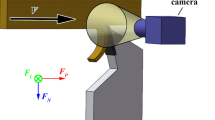Abstract
The paper deals with the verification of suitability of water jet and abrasive water jet application for the disintegration of rotating samples of wood plastic composites (WPCs) with diameter d = 36 mm. The influence of selected technological factors (traverse speed of cutting head v [mm/min] and size of abrasive particles [MESH]) on the topography of resulting surfaces has in particular been studied. Surface topography and quality have been assessed using the methods of optical and confocal microscopy and optical profilometry. The presented procedures and results of experiments demonstrate the technology of abrasive water jet as an appropriate tool for the rough machining of WPCs and similar composite materials. In addition, the application of this technology can effectively solve the problem of the melting of the polymer matrix and its subsequent sticking to the functional parts of a cutting tool resulting from conventional turning.
Similar content being viewed by others
References
Youngquist JA (1999) Wood-based composites and panel products. In: Wood handbook—wood as an engineering material. Madison US Dept Agric, 10.1–10.31
Clemons C (2002) Wood-plastic composites in the United States: the interfacing of two industries. Forest Prod J 52:10–18
Hashish M (1995) Abrasive jets. In: Labus TJ (ed) Fluid jet technology: fundamentals and applications. WJTA, St. Louis, pp 4.1–4.52
Sitek L, Foldyna J, Souček K (2005) Shaping of rock specimens for testing of uniaxial tensile strength by high speed abrasive water jet: first experience. In: Konečný P (ed) Eurock 2005—impact of human activity on the geological environment. A.A. Balkema, London, pp 545–549
Maňková I (2000) Progressive technologies. Vienala, Košice
Hashish M (1987) Turning with abrasive-waterjets—a first investigation. J Eng Ind Trans ASME 109:281–290
Zhong ZW, Han ZZ (2002) Turning of glass with abrasive waterjet. Mater Manuf Process 17:330–349
Manu R, Babu NR (2009) An erosion-based model for abrasive waterjet turning of ductile materials. Wear 266:1091–1097
Uhlmann E, Flögel K, Kretzschmar M, Faltin F (2012) Abrasive waterjet turning of high performance materials. In: Wegener K (ed) Procedia CIRP 1, Elsevier, 409–413
Li W, Zhu H, Wang J, Ali YM, Huang C (2013) An investigation into the radial-mode abrasive waterjet turning process on high tensile steels. Int J Mech Sci 77:365–376
Liu D, Huang C, Wang J, Zhu H, Yao P, Liu Z (2014) Modeling and optimization of operating parameters for abrasive waterjet turning alumina ceramics using response surface methodology combined with Box–Behnken design. Ceram Int 40:7899–7908
Hloch S, Hlaváček P, Vasilko K, Cárach J, Samardžič I, Kozak D, Hlavatý I, Ščučka J, Klich J, Klichová D (2014) Abrasive waterjet (AWJ) titanium tangential turning evaluation. Metalurgia 53:537–540
Pramanik A (2014) Developments in the non-traditional machining of particle reinforced metal matrix composites. Int J Mach Tool Manu 86:44–61
Shanmughasundaram P (2014) Influence of abrasive water jet machining parameters on the surface roughness of eutectic Al-SI alloy-graphite composites. Mater Phys Mech 19:1–8
Szymani R, Dickinson FE (1975) Recent developments in wood machining processes: novel cutting techniques. Wood Sci Technol 9:113–128
Mazurkiewicz M (1984) The separation of wood fibres by a high pressure water jet. In: Proc. of 7th international symposium on jet cutting technology, BHRA, Cranfield, 389–394
DuPlessis MP, Hashish M (1978) High energy water jet cutting equations for wood. J Eng Ind Trans ASME 100:452–458
Lee HW (2004) Abrasive-assisted high energy water-jet machining characteristics of solid wood. J Korean Wood Sci Technol 32:1–7
Wang Z (2012) An investigation on water jet machining for hardwood floors. Eur J Wood Wood Prod 70:55–59
Barcík Š, Kvietková M, Aláč P (2011) Effect of the chosen parameters on deflection angle between cutting sides during the cutting of agglomerated materials by waterjet. Wood Res-Slovakia 56:577–588
Kminiak R, Gaff M (2014) Fabrication of structural joinery items of solid wood by the mean of abrasive water jet method. Wood Res-Slovakia 59:499–508
Barcík Š, Kvietková M, Gašparík M, Kminiak R (2013) Influence of technological parameters on lagging size in cutting process of solid wood by abrasive water jet. Wood Res-Slovakia 58:627–636
Kvietková M, Barcík S, Gašparík M (2014) Optimization of the cutting process of wood-based agglomerated materials by abrasive water-jet. Acta Silv Lign Hung 10:31–47
Author information
Authors and Affiliations
Corresponding author
Rights and permissions
About this article
Cite this article
Hutyrová, Z., Ščučka, J., Hloch, S. et al. Turning of wood plastic composites by water jet and abrasive water jet. Int J Adv Manuf Technol 84, 1615–1623 (2016). https://doi.org/10.1007/s00170-015-7831-6
Received:
Accepted:
Published:
Issue Date:
DOI: https://doi.org/10.1007/s00170-015-7831-6




